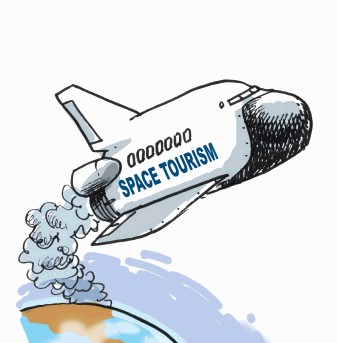SPACE TOURISM
676 total views, 1 views today

Vacations are the best part of the year for many. All that fun, and frolic, whether it is with family or friends. It’s a great time to connect with loved ones, a time to create memories mixed with emotions, and laughter.
As a child, summer vacations meant a trip to any hill station. Simla had been a forever favorite. And that long drive uphill seemed like the most extravagant thrill with mother’s goodie snacks at every halt! The waterfalls, mountains, but most of all, the quality family time, was the icing on the cake. We sang we joked, we laughed, and we also fought especially to get the window seat. It was indeed an overwhelming experience despite the fact that it was repeated every single summer vacation. Of course, life goes on, and everything changes, because after all, the only thing that is constant in life, is change!
And now the biggest buzz around the whole world is about that form of vacation, excursion, etc, whatever you may like to call it, known as SPACE TOURISM. Yes, people are traveling into space for a phenomenal price! What an idea, I must say? Let us dive in and see the scientific aspect of SPACE TOURISM.
Space tourism, recreational space-faring, either on established government-owned vehicles such as the Russian Soyuz and ISS (International Space Station) or on vehicles addressed by private companies. Since the flight of the world’s first space tourist, an American multimillionaire, Dennis Tito, on April 28, 2001, space tourism has acquired new eminence as more suborbital and orbital tourism opportunities have become available. Mainly, Space tourism can include visiting space-focussed museums, watching rocket launches, or traveling to destinations popular for stargazing, amongst other space-related activities.
There are currently six major space companies that are planning to arrange touristic flights to space; Virgin Galactic; Blue Origin, SpaceX, Boeing, Axiom Space, and Space Perspective. Although the first two are centered on suborbital flights, Axiom and Boeing are focused on orbital missions. SpaceX, in its turn, is working on lunar tourism in the future. Concurrently, Elon Musk’s company has permitted its Crew Dragon spacecraft to be chartered for orbital flights, as it happened with the Inspiration4 3-day mission. Space Perspective is amplifying a different balloon-based system to carry customers to the stratosphere and is planning to start its commercial air service in 2024.
Recently, NASA has given the go-ahead to another private crewed mission to the International Space Station (ISS). The agency will work with Axiom Space to find a window for the Houston-based company’s second ISS mission. That flight, known as Ax-2, is currently scheduled to launch from NASA’s Kennedy Space Center in Florida between fall 2022 and spring 2023. Axiom has contracted with SpaceX to launch four crewed missions to the ISS using Crew Dragon capsules and Falcon 9 rockets. The first of those flights, Ax-1, is scheduled to launch on Feb. 21, 2022.
For now, the most crucial barrier for space tourism is price. Virgin Galactic costs $250,000 for a 2-hour suborbital flight at an altitude of 80 km; Blue Origin approximately costs $300,000 for 12 minutes suborbital flight at an altitude of 100 km; Axiom Space costs $55 million for a 10-day orbital flight; Space Perspective costs $125,000 for a 6-hour flight to the edge of space (32 km above the Earth). The cost depends, but suborbital space flights are always inexpensive.
Subsequently, rocket launches are harmful to the environment in general. During the burning of rocket fuels, rocket engines release harmful gases and soot particles (also known as black carbon) into the upper atmosphere, resulting in ozone depletion. Moreover, the only fully reusable space vehicles currently in use are Blue Origin’s New Shepard and SpaceShipTwo. Both of them perform suborbital spaceflights. SpaceX is developing its Starship to be a fully reusable orbital space vehicle.
As the space tourism industry grows, the ranks of spaceflight participants will increase, and suborbital and orbital flights will inevitably give way to lunar excursions and trips to Mars and beyond, by which time-space tourism will be operating as a full-fledged industry capable of truly opening the frontier of space. Most likely, the price for space travel will reduce over time as well.
I am sure this must be an adventure worth experiencing!
